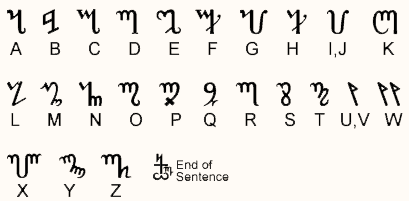 |
|
| Home Wicca
101/FAQ Glossary About
the Author Email
the Author Blog
/ Question of the Day Email
List |
The Theban Alphabet
also known as the Witches Alphabet or the Runes of Honorius
Calling this alphabet runic is erroneous - runes are straight-edged - and there's no evidence of this system being associated with witches before the 20th century.
How old it really is is unknown. It is first mentioned in Cornelius Agrippa's Three Books of Occult Philosophy published in Antwerp in 1531, attributing them to one "Honorius of Thebes." This is assumed to be reference to the author of Liber Juratus, or the Sworne Booke of Honorius, yet the letters never appear in the the Liber Juratus. If the alphabet is his, it apparently appeared in a work that no longer exists. (The better-known Grimoire of Honorius is a 17th-century forgery)
The character for "W" shown below is not part of the original alphabet. Indeed, the absence of unique characters for "J", "U" and "W" indicate a possible connection with the pre-11th century Latin alphabet, as those letters are much younger than the rest of our alphabet.
It is certainly an invented alphabet such as an alchemical cipher. The flourishes it boasts are not practical to writing and should have naturally eroded away. The letter for "K" for example, is almost impossible to write left to right with a single pen stroke.
The Golden Dawn and its successor orders such as the Ordo Templi Orientalis adopted the alphabet in the 19th century, and this appears to be Gerald Gardner's source. Garderians use this alphabet frequently. It is more rare among the other Traditions.1
The purpose of using an unfamiliar alphabet is to abstract it from the writer's native language. This causes the writer to concentrate more fully upon the inscription and the greater task at hand. Because of this, the Theban alphabet is mostly employed in the makings of talismans and other ritual work. Some use it in their Book of Shadows as a code so no one else can read it - another throwback to the Burning Times myth.

1 http://www.catb.org/~esr/unicode/theban/, January 2003.
| © Catherine Noble Beyer, 2002 - 2011 * Awards |